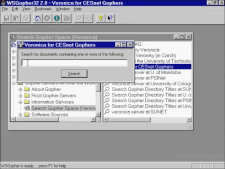Veronica
Short for "Very Easy Rodent-Oriented Netwide Index to Computerized Archives."
Veronica was a tool developed in the early 1990s for searching Gopher servers. The "rodent-oriented" acronym reflects how Veronica enabled keyword searches across Gopher, an information network structured as menus and text files.
The Gopher system, developed at the Univerity of Minnesota, grew to over 6,000 global servers at its peak. Browsing the network was time-consuming and difficult. Searching the network with Veronica was more efficient as it quickly listed Gopher menu items and documents that matched search phrases.
Unlike modern search engines, which scan entire documents for content, Veronica only indexed the titles of Gopher menus and items. The lightweight approach allowed it to query multiple servers quickly but produced limited results. Users could employ basic logical operators like AND, NOT, and OR to refine searches, and use an asterisk (*) for wildcard searches. These features were akin to Unix search syntax, making Veronica intuitive for tech-savvy users at the time. ?
Later versions of Veronica extended beyond Gopher to include searches of select websites, newsgroups, and FTP servers. It briefly bridged the gap between Gopher's text-based environment and the Web. Although its influence waned with the decline of Gopher, Veronica had a significant impact on the future of the Internet. The tool's popularity made it clear that users preferred to search, rather than browse, for information online. This shift led to the development of early search engines like WebCrawler, Lycos, Infoseek, AltaVista, and Excite. Yahoo, which started as a directory in 1994, transitioned to a search-focused site a few years later, followed by the launch of Google in 1998.
 Test Your Knowledge
Test Your Knowledge